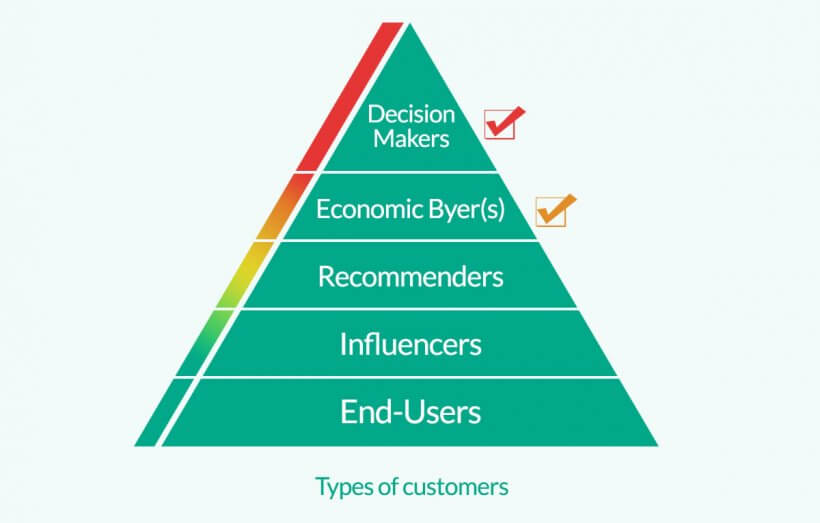Relevant leads towards a successful sale
Are you wondering how you can gather relevant leads to make a decent sale? Use influence maps! Influence maps are visual models showing the interests of different groups and the people who influence a project or decision the most.
Managers have different interests than employees and customers influence organizations differently from suppliers. You need influence maps during your customer development process, to track down which people affect (or influence) decision making in adopting your product.

Are your leads relevant to your business?
Relevant leads are no ordinary leads, as you might suspect. Different types of businesses need different types of leads towards healthy business development. And the process to help you get them is different, based on the type of your customers. While on B2B business models a lead is inherently more difficult to acquire, the end result may be spectacular in converted value. It can even be quite more affordable than its equivalent in B2C business models.
The types of customers
There are several types of customers. Each of them requires a different approach and will, perhaps, respond to a different kind of communication channel. To elaborate, there are different types of customers to derive leads, in terms of the ways in which they affect our sales process. Hence, the need for an influence map; sort of an equivalent to the food chain, for sales.

The end users
Typically, the people who will be using our product or service are called “end-users”. That is, because they are the final recipients of our solution; to use it in solving their problem.
Oftentimes, opting for a B2B model or a B2C model is irrelevant. They are still our end-users. Despite the differences in the methods of marketing our product or service, we are still talking about people. The methods we will be using to verbally promote our work, is virtually the same in both cases.
But how can we convince these people of our value proposition? Well, in all actuality, most of the time, trust can be found in subtle details. And if we cannot wait for natural events run their course, we can skip a step and go to the people that influence our end users. These would be our typical influencers or recommenders.
Influencers
Typically, influencers don’t directly promote a service or product. So, it’s not really a matter of innovation. But they know the market, they know what kind of problems the end users are facing daily, and they “have friends in high places” 🙂
While this last bit may occasionally be true, influencers are people that have dedicated a huge amount of effort in contributing considerable progress to their industry. Usually, we’ll find they’ve done all the hard parts of market research on their own. And we can use their incredibly valuable insights.
Either way, influencers are trusted in their industry. And they tend to be able to turn things around towards some helpful direction. In other words, they have a bit of a say in steering the ship.
Recommenders
We’ve all seen this type of user. Whether it’s an actual user that became an affiliate of ours promoting our product or service to their peers, or a YouTuber offering product reviews, suggesting a user should or shouldn’t buy them, these are “recommenders” of sort.
Recommenders are more eager to test new things and try to integrate them to their workflow, for the better. They are really close to an influencer’s mindset. What isn’t exactly obvious is, they are also quite close to an early adopter’s mindset. And we’re going to need some of those (early adopters) to get started with our product.
If we can get our product to be used, tested and evaluated by a recommender or two, they may recommend it to their followers; provided their review matches face value of the product. Their followers are basically the end users we’re trying to reach. Any successful recommendations will probably result in some new business for us. However, if we are using a B2B model, even if we have convinced the end users, how do we know if they are the ones who are buying?
Economic byers
Let’s assume we’re trying to get systems’ administrators, in certain types of companies, use our product. Most of the time, systems’ administrators are the ones to suggest solutions to problems, but there is a catch. They are usually not the ones to approve a purchase. In other words, they’re not the economic buyers. They’re the end users, or the ones that integrate our solution to a workflow, on account of the end users. This means, convincing them alone, is not enough to close a deal.
The actual economic buyer in this example would be a Chief Technical Officer (CTO), or Chief Information Officer (CIO), or even a Chief Financial Officer (CFO); notice they are all C-level executives. This is usually the standard in B2B models. Eventually, we’re going to need their approval, as well.
Decision makers
We may have convinced every other type of customer that makes sense for our business model about the value of our solution. But, it goes without saying, if they are not the ones to make the final decision, no new business will be coming our way. So, our work is not done yet.
Assuming we’ve caught the interest of the end user, who has brought our solution to their manager’s attention, who has made a recommendation to their CTO. So, people are already talking about our product. All this begs the question(s): “Who’s deciding? Are we buying this?”
At the end of the day, there is usually one person that will decide for or against a purchase. Someone that perfectly understands the business model, and has the ability to foresee the value of such an investment. We need to find them and get them to buy in. Otherwise, we’re building awareness without the added benefit of a closed deal. And to do that, we’re going to need an organizational map.
The influence map towards getting relevant leads
Now that we know what types of customers there are available to us in attempting to create brand awareness and close a deal, verifying the viability of design for our sales cycle, we’re one step closer to actually close a deal. So, what can we deduce from all this?
- Reaching out to and convincing the end user is usually not enough, especially in B2B models
- Convincing influencers or recommenders to use our product, may not be enough for them to become our evangelists (or marketers, for free)
- Even if the budget to buy our product is approved, the prospective customer should make a final decision for or against investing in our solution, towards long term value
In essence, we need to map out who influences which step of the sales process. And we need to do it for every different customer segment we’re targeting, as there may be several subtle differences in company structures. Chances are, we will need to get several people to buy in to our solution, before any decision can be made on the customer’s side. Knowing who these people are and bringing them on board, as early on in the process as possible, will greatly reduce the time needed to close the deal.
What are the benefits in getting relevant leads?
In B2B models, closing a deal can be hard as nails. Building all the influence maps we need ahead of time, allows us to fine-tune our customer personas, sort out our target segments, find out the size of our addressable and serviceable markets and tweak our sales process to include everything we need to follow up the sale, to the top of the chain of command. This can be the difference between making the sale, or breaking it.
[newsform label=”Learn more about your startup”]
